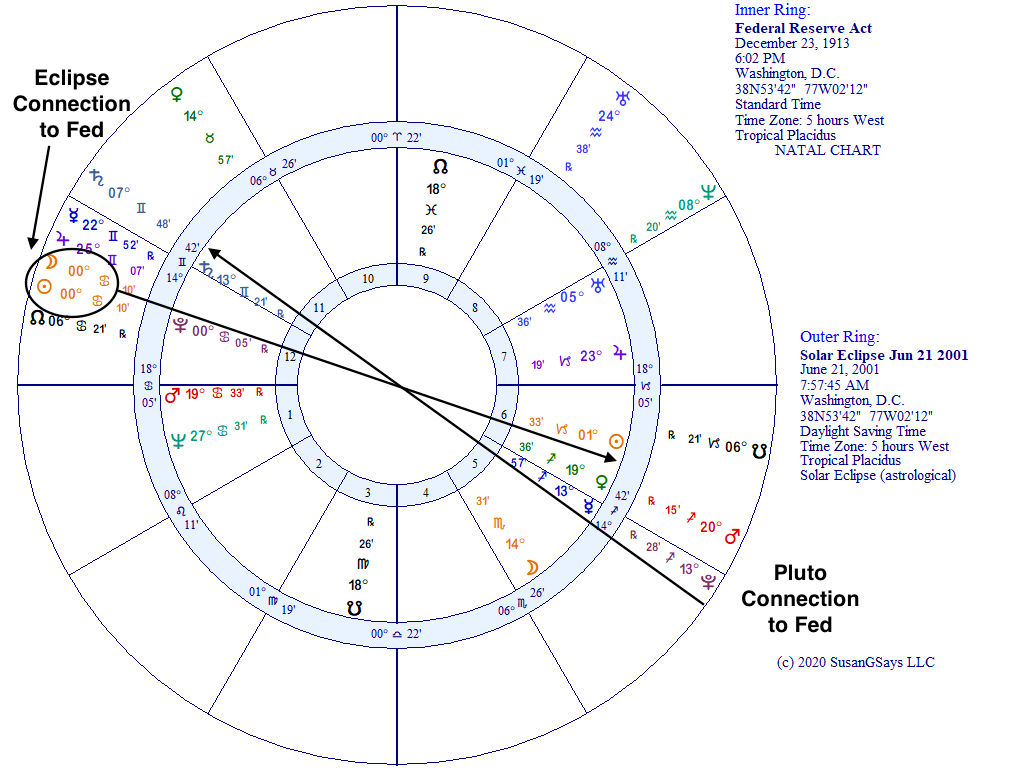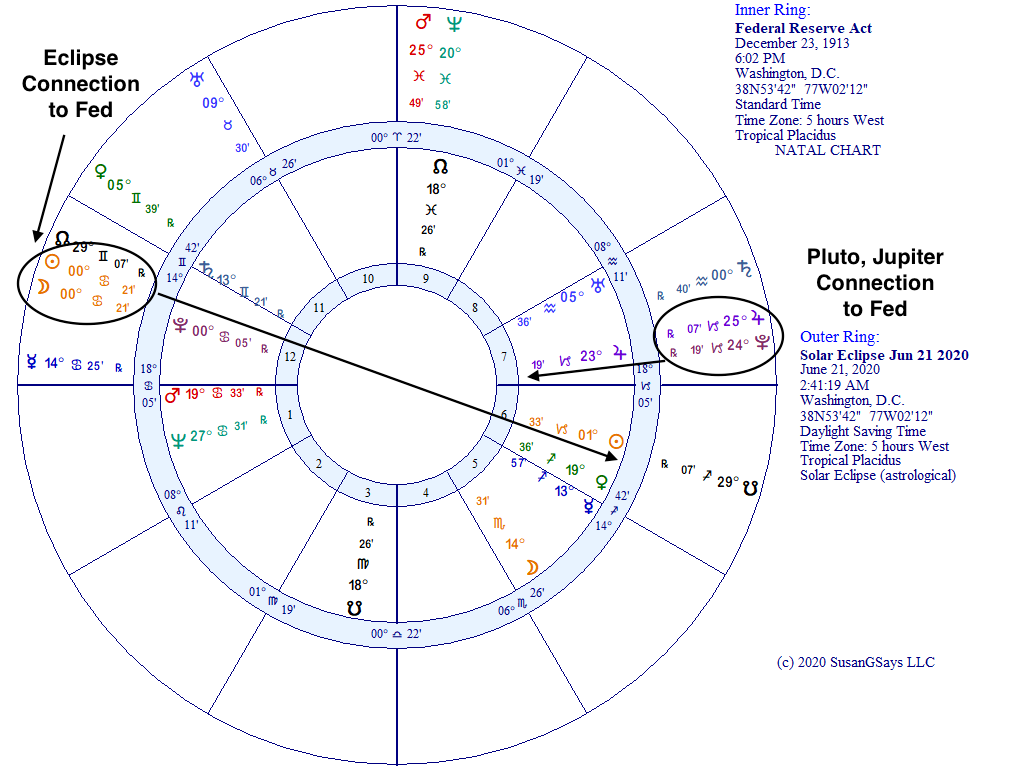By Susan Abbott Gidel
The June 21, 2020 solar eclipse at 00 Cancer directly affects two powerful planets in the Federal Reserve’s natal horoscope—the Sun and Pluto—in a repeat performance of the solar eclipse in June 2001, also at 00 Cancer. But, it’s the simultaneous transit of Pluto and Jupiter to the Fed’s natal Jupiter that will make this time a whopper in Fed history.
These two summer-solstice eclipses are noteworthy in that they are the only two since 1900 to occur at zero degrees of a Cardinal zodiac sign (also Aries, Libra, Capricorn), any of which are considered “world points.” Thus, this summer-solstice eclipse indicates that the Fed is a key player in world events in 2020, just as it was in 2001.
Each eclipse was conjunct the Fed’s natal Pluto at 00 Cancer and opposite its natal Sun at 01 Capricorn. The stronger connection is the conjunction, which highlights the Fed’s power (a Plutonian characteristic) over domestic matters (Cancer’s specialty). The eclipse also highlights the Fed’s core identity (Sun) as a responsible institution with authority (Capricorn).
Importantly, transiting Pluto also was in play at each of these times, which brings further color into the Fed’s role. In 2001, it concerned transparency of its activities. In 2020, in conjunction with Jupiter, it concerns massive debt expansion to support society.
2001 Eclipse and 9/11
In 2001, the 9/11 attacks—less than three months after the world-point eclipse—shook the world and world economies. That year, recession had begun in March after a record 120-month expansion. It also had been 12 months after the dot.com stock market bubble burst, which had sent the S&P 500 lower by 28% over that year. To combat the situation, the Fed began a steady program of lowering the Fed Funds rate beginning in January 2001, which continued after 9/11.
The Fed Funds rate began 2001 at 6.5%, but steadily dropped at each of 11 FOMC meetings to end the year at 1.75%. This was the first time the Fed Funds rate had been below 2% in 40 years. Rates remained below 2% for the next three years, then rose to a peak of 5.25% in 2006 before falling to effectively zero from December 2008 through December 2015 following the Great Recession.
Figure 1 shows the connections between the natal horoscope for the Federal Reserve (December 23, 1913, 6:02 pm, Washington, D.C.) and the June 21, 2001 solar eclipse.

The New Moon/Solar Eclipse was conjunct the Fed’s natal Pluto and opposite its natal Sun, bringing those two planets under strong influence from the eclipse. The eclipse’s meaning, based on its originating horoscope, was one of being over-excessive to the point of obsession, with news that transforms the situation. The 9/11 attacks occurred less than three months later, certainly within effective range for an eclipse.
Note also that transiting Pluto (in the outer horoscope ring), was at 13 Sagittarius, exactly aligned with the Fed’s natal Mercury at 13 Sagittarius and natal Saturn at 13 Gemini. Opposite Saturn, the transit portends a restructuring that lays the groundwork for the future. Conjunct Mercury, the transit suggests flexibility and a quest for improved communication.
It was under this Pluto transit’s influence that the Fed began announcing the results of each of its meetings, beginning in February 2000, when Pluto was at 12 Sagittarius. True to the transit’s meaning, the meeting announcements transformed the Fed’s approach to communicating its actions, which previously had been kept under much tighter wraps and encouraged the never-ending game among market-watchers of reading the Fed’s tea leaves.
2020 Eclipse and Coronavirus Pandemic
The economic situation in early 2020 was eerily similar to the one the Fed faced in 2001. First, the U.S. economy entered recession in February, ending the new record of 128 months of economic expansion. Second, the S&P 500 had peaked in late February, dropping 35% over the next four weeks. Third, the Fed once again dropped interest rates dramatically to combat a pandemic-connected economic shutdown that had global implications.
From mid-February Congressional testimony that the pandemic could mean a potential drop in interest rates from their current level of 1.75%, the Fed dropped rates twice in the next month (each outside of its regular meeting schedule). By March 15, the Fed Funds rate was effectively zero, just like it had been for seven years after the 2008 financial crisis.
Figure 2 shows the connections between the natal horoscope for the Federal Reserve (December 23, 1913, 6:02 pm, Washington, D.C.) and the June 21, 2020 solar eclipse.

Like the 2001 eclipse, the 2020 eclipse is conjunct the Fed’s natal Pluto and opposite its natal Sun, emphasizing both its power and identity. This eclipse belongs to different family of eclipses, however. The 2020 eclipse’s meaning concerns restriction, inhibition, restraint, separation, illusions and the blocking of individuals—all of which sounds like it is in the wheelhouse of a pandemic-induced economic shutdown.
Massive Debt Expansion
Interestingly, transiting Pluto in 2020 is once again aligned directly with a planet in the Fed’s natal horoscope. This time, that planet is Jupiter, the largest planet in the cosmos. Hence, Jupiter’s preponderance to expand anything it touches. In this case, that would be the Fed’s power to expand debt, which is ruled by Pluto. Simultaneously, transiting Jupiter also is conjunct the Fed’s natal Jupiter, a double-whammy that suggests practically unlimited debt expansion.
The Fed began adding liquidity in September 2019 when it intervened in the repo market for the first time since 2008. With several new programs announced since March 2020, including $1.5 trillion for repos, $2.3 trillion for bond-buying and a commitment to “using its full range of tools to support households, business, and the U.S economy overall in this challenging time,” the Fed’s balance sheet had increased 72% by mid-June to $7.2 trillion from $4.2 trillion at the start of the year.
The type of expansion currently underway ties in nicely with the delineation of the Jupiter and Pluto transits to the Fed’s natal Jupiter. Pluto conjunct Jupiter suggests a rebirth of hope, efforts that benefit society and opposition from authorities. Jupiter conjunct Jupiter makes the balloon as big as it possibly can get, with sudden windfalls and the ability to expand business efforts.
More Expansion News in July and November
This is the first time in the Fed’s history that transiting Pluto has aligned with its natal Jupiter because it takes 248 years for Pluto to travel around the entire zodiac. So, the Fed’s societal transformation energy is a once-in-our-lifetime phenomenon, but one that could last until early 2022 when transiting Pluto moves more than 2 degrees away from the Fed’s natal Jupiter.
However, Jupiter moves much more quickly, taking just 12 years to traverse all 12 zodiac signs. Thus, this year’s “Jupiter return” in the Fed’s natal horoscope—and propensity to blow up the balloon to its biggest size—last occurred on December 6, 2008. Just two weeks earlier, on November 25 with transiting Jupiter at 20 Capricorn, the Fed announced the Term Asset-Backed Securities Loan Facility (TALF) program to increase the flow of credit to households and businesses affected by the 2008 financial crisis.
This year, the Fed announced another TALF program as well as a broad range of other supportive efforts on March 23, 2020. On both dates—nearly 12 years apart—transiting Jupiter was conjunct the Fed’s natal Jupiter at 23 Capricorn; in 2020, it was exact to the degree.
Transiting Jupiter remains in range of the Fed’s natal Jupiter through the end of November 2020, and will be exactly at 23 degrees Capricorn again on July 2-9 and November 14-19, periods to watch for further debt expansion announcements. During Jupiter’s retrograde period in July, that could mean a review of the programs announced in March. When Jupiter makes its final pass through 23 Capricorn in November, the results of the March programs could become clear.
Looking ahead to the Fed’s next Jupiter return, it will arrive in March 2032. That is just three months before a new 45-year economic cycle begins as Saturn and Uranus come together in a conjunction. Typically, the Saturn/Uranus conjunction marks a significant low in the stock market and the economy. The Fed’s Jupiter return and propensity to be in a situation that demands easing supports the idea that 2032 will be a pivotal year.
(c) Copyright 2020 SusanGSays LLC